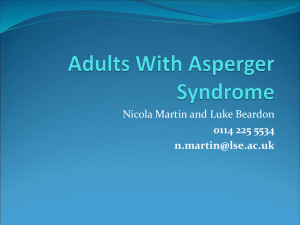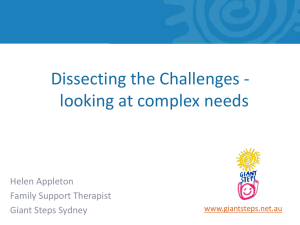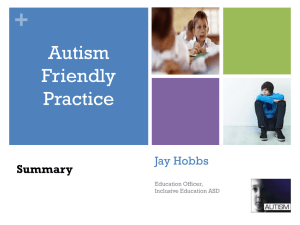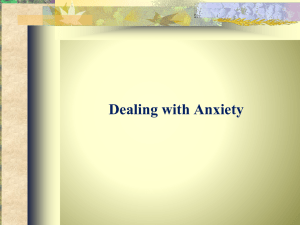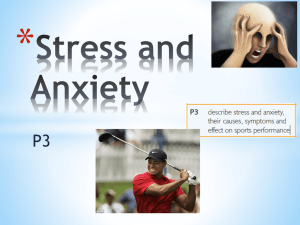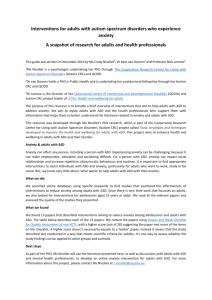The Spectrum Of Autism: Anxiety and Stress
advertisement
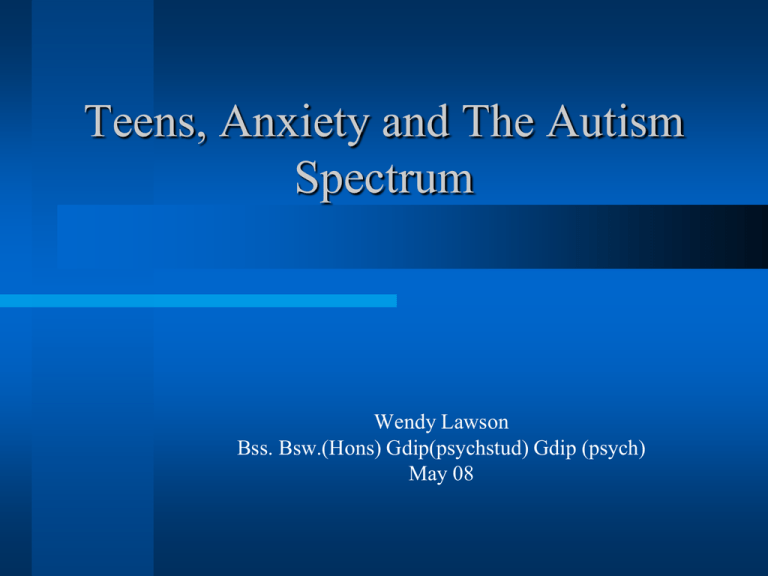
Teens, Anxiety and The Autism Spectrum Wendy Lawson Bss. Bsw.(Hons) Gdip(psychstud) Gdip (psych) May 08 What to expect from this talk We will explore: the cognitive style in autism the cognitive style in typicality What this means with regard to being an AS teenager stress and anxiety: statistics, reasons and what might be helpful for us all That’s typical! “That’s typical” I heard her say. I wondered what she meant? “You always want it your way” She echoed without relent. I waited, silent as a bird, And pondered on her words. She just kept talking, I kept walking, What was it that I heard? That’s typical “I always want it my way?” What other way could there be? I only know the proper way, The way that’s there for me. If we do it her way, It wouldn’t be right at all. It would be wrong and all along, I’d know it’s wrong and not OK! That’s typical So, why can’t she understand? What is it she doesn’t get? I must firmly stand my ground, I mustn’t give in yet! If I give up she’ll never learn. She’ll never know the way. She calls it “being stubborn”, But, I’m scripted for this play. Cognitive Style in AS Monotropism Literality Thinking in closed pictures Lack of generalisability Timing and sequencing difficulties Forward thinking tends to occur when connected with interest FOR MORE INFO... Wendy’s books: Build Your Own Life; Understanding and working with the spectrum of autism. Cognitive Style in Typicality Polytropism Non-literality Thinking in open pictures Generalisability Understanding timing and sequencing Can forward think outside of one’s interest ASD (attention) Narrow and Deep NT (attention) broad and shallow other interest Highly focused Interests take precedence Multiple diffuse interests ATTENTION………. -----attention Tree of Life Experience ----- attention Stress Important component for keeping skin over body and enabling body to function effectively When is stress not good? When it is dis-stress. This causes lack of body/mind rest and is very tiring. FOR MORE INFO... Wendy’s books, general reading on stress, general reading on autism. Anxiety, what is it? A state of being/mood/emotion Negative affect Physical feelings of tension, increased heart rate, ‘funny tummy’ etc. Worry/apprehensive about some future event/ misfortune that might occur – ‘what if….’ thinking style (e.g.. What if I fail my exam; what if I miss the bus…..) Why Anxiety and Stress? ASD population prevalence 20-40% Non ASD population 3-13% (Louisa Caroll, Clinical Psychologist, Autism Ass. NSW). Growing awareness of anxiety problems in the ASD population is not yet accompanied by growth in scientific knowledge about assessment and/or treatment of anxiety, especially in children. How is it expressed? Physiologically- physical reactions triggered by autonomic nervous system (pounding heart, rapid breathing, sweaty palms, nausea). Cognitively: negative reactions and irrational beliefs. Behaviorally: avoidance/escape or externalising/ challenging behaviors (lashing out or self harm). When is anxiety a problem? When it is out of proportion to the reality When it is chronic and can’t be reasoned away When it is related to innocuous situations When it leads to constant avoidance Childhood Anxiety Disorders Separation Anxiety Disorder (SAD) Specific Phobias Social Phobia Obsessive Compulsive Disorder (OCD) Generalised Anxiety Disorder (GAD) Panic Disorder Why are individuals with ASD vulnerable to Anxiety Disorders? Genetic factors (family history of anxiety or other mood disorders) Disposition: temperament, personality (shy, anxious) Relationship factors – parenting styles & modeling of caution/anxious behavious Cognitive factors- information processing styles and negative self-talk Triggers (Processing Information in Autism) Relational: monotropic individuals relating to polytropic individuals. What does this mean for communication? What does this mean for understanding and comprehending the world we all share? – Change, literality, closed pictures, forward thinking, learning and mistakes? What does it mean for social skills and acceptance? What about sensory sensitivities? What does this mean for behaviour? Inappropriate behaviour Excessive talking or no talking – Frozen states (catatonia), rituals, repeated obsessive behaviour. Inability to understand or accept ‘it’s OK to do it differently’ stuff. Overwhelming feelings of exposure Why Is Anxiety Difficult To Overcome? ASD might mean individuals have reduced information or an incomplete picture of the situation. This leads to: – Lack of knowledge of other ways to respond – complete belief in the outcome of the feeling – Feelings stronger than words Management Strategies Using words that don’t address the underlying issues won’t work. – ‘it won’t hurt you’; ‘don’t be silly’; ‘stop this’. Address the real issue by: – – – – Understanding ASD Modify language Reduce demand Put together an intervention or program Consider other possible supports – Medication (never use in isolation) How to get there Technology is often a big part of the answer Computers (use scanned in pics; calendars; lists; power point; email) Cameras TV Mobile phones Dicta phones etc support will vary according to need Practical things that enable me to help myself – Diary and planners – To do lists – Structuring my day – Structuring my free time – Sleep hygiene Aim to give strategies that individuals can use Teach concepts (reality v fantasy) Role play Practice Give self-help skills (Build your own life) Be patient with us! I’m not stupid, just autistic Please respect who I am Please help me to respect who you are Communication is a two way street Helping me to help myself is terrific. Understanding I might still need support as I age is wonderful Aggression What am I feeling? How can I express my feelings? How can I make people listen? What gets things to change? What ‘tools’ do I have at my disposal? What have I learnt? manipulation Change is terminal, I must prevent it. The unknown is scary, I must stay with what and who I know. I don’t understand that there are other ways to know and do things, (I am not polytropic) I must always do things the same way and make others do the same. I lack connections, unless someone helps me to build them Anxiety I am anxious because I don’t know what will happen How can I be sure that I am OK? My feelings are stronger than the words people give me. Which are true? Sress I am very uncomfortable. Stimming might help make me feel comfy again. I am over loaded, I need to avoid all demand. I cannot learn any new task or complete my usual activity when I feel this way. I need space, quietness, decreased demand and familiarity. All Behaviour is Functional If you want my behaviour to change, you must teach me how to behave differently. I may need pictures/photos to help me understand the procedure and process that you want me to take. I am happier when you are calm and happy. I may depend upon you to be confident, where I am not. Resources Wendy’s Books Wendy’s web page: www.mugsy.org/wendy Other books and web pages Autism aware professionals Extended family and friends Each other

